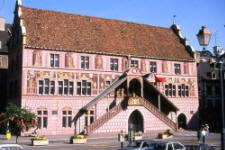|
An unusual “Town of Art and History”
A bit of history…
 Mulhouse
was mentioned for the 1st time in 803 under the name of
Mulinhuson (mill houses) and, legend has it, was founded around
a mill. It belonged to the Germanic Roman Holy Empire
when it was founded, and obtained the status of an imperial town
in 1308, thereby answering directly to the Emperor himself. Mulhouse
was mentioned for the 1st time in 803 under the name of
Mulinhuson (mill houses) and, legend has it, was founded around
a mill. It belonged to the Germanic Roman Holy Empire
when it was founded, and obtained the status of an imperial town
in 1308, thereby answering directly to the Emperor himself.
In 1354, it joined the Decapolis, a federation of 10
imperial towns. In 1515, it signed an alliance treaty
with the thirteen Swiss cantons. At the end of the Hundred Years
War, the whole of Alsace became French... except Mulhouse, which
obtained the status of independent republic.
 Mulhouse,
a Protestant enclave in the Kingdom of France, was unaffected by
the prohibition on the production of Indiennes (floral printed
fabrics) which had been in force on French territory
since 1686. Its destiny was sealed
in 1746 when the first Indienne factory was founded by
four young entrepreneurs: Samuel Koechlin, Samuel Koechlin,
Jean-Jacques Schmalzer, Jean-Henri Dollfus Mulhouse,
a Protestant enclave in the Kingdom of France, was unaffected by
the prohibition on the production of Indiennes (floral printed
fabrics) which had been in force on French territory
since 1686. Its destiny was sealed
in 1746 when the first Indienne factory was founded by
four young entrepreneurs: Samuel Koechlin, Samuel Koechlin,
Jean-Jacques Schmalzer, Jean-Henri Dollfus
and Jean-Jacques Feer.
By the time the Kingdom of France legalised Indiennes in 1759,
the industry
in Mulhouse already had a considerable head start! This was the
beginning of an industrial golden age: in a few years, the small
craft town of the 18th century was profoundly transformed.
 In
1798, the small, prosperous republic of Mulhouse chose
to become part of France. In
1798, the small, prosperous republic of Mulhouse chose
to become part of France.
In 1846, Mulhouse, had 45 spinning mills. This period
also saw the creation of the forerunner of the SACM and ALSTOM,
and the commissioning of the 1st railway line in France, between
Mulhouse and Thann (1839). The paternalistic, Protestant ruling
classes of Mulhouse, who were mainly freemasons, were
responsible for a great deal of economic, technical and social
progress.
In 1822, Europe’s first chemistry school opened - it
still enjoys an excellent reputation to this day. In 1826, 22
young industrialists founded the Mulhouse Industrial Society
(Société Industrielle de Mulhouse - SIM), which is still
active today, thus helping to improve local people’s living
conditions: they created the zoological and botanical park
(1868), a day nursery, Hasenrain hospital (1899), the first
workers’ housing development in France (1853)...
Between 1870 and 1945, Mulhouse, like the rest of Alsace,
changed nationality 4 times. The town suffered severe damage at
the end of the 2nd World War.
 In the 1970’s, Mulhouse was hit hard by the 2 oil crises
and saw its flagship industry, textiles, move to the Asian
countries. Yet it remained dynamic and reinvented itself, with
the opening of the Peugeot factory, the international
expansion of Clemessy and the creation of the University of
Upper Alsace. In the 1970’s, Mulhouse was hit hard by the 2 oil crises
and saw its flagship industry, textiles, move to the Asian
countries. Yet it remained dynamic and reinvented itself, with
the opening of the Peugeot factory, the international
expansion of Clemessy and the creation of the University of
Upper Alsace.
In 2006, the arrival of the tram gave the town a new
vision, and was followed in 2010 by the introduction of
France’s first ever tram-train, connecting Mulhouse to the
Thann Valley (30 km). |






|